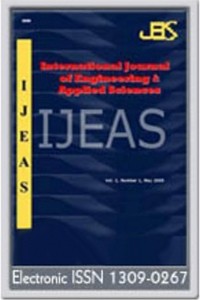APPLICATION OF DETERMINISTIC SEISMIC HAZARD ANALYSIS ON THE AREA OF 1970 GEDIZ EARTHQUAKE
Deterministic seismic hazard analysis is used to evaluate the effects of potential earthquakes. By using this approach, approximate peak ground acceleration (PGA) values can be estimated for the area of interest. In this research, the area which was severely affected by the 1970 Gediz earthquake has been studied to assess the PGA distribution. Detailed geological characteristics and scientific parameters (unit distribution, fault locations and attenuation relationships) are the main input for the results. Four main fault zones are used for modeling and according to marks, peak earthquake magnitude generated from the fault zones and type of geological units are the main interest for the location of the settlements
___
- [1] Abrahamson, N.A., State of the practice of seismic hazard evaluation, GEOENG 2000 Conference Proceedings, Melbourne, Australia, 2000.
- [2] Reiter, L., “Earthquake Hazard Analysis”, Colombia University Press, 1990
- [3] Kramer, S.L., Geotechnical Earthquake Engineering, New Jersey: Prentice Hall, 1996.
- [4] Krinitzsky, E. L., How to combine deterministic and probabilistic methods for assessing earthquake hazards, Engineering Geology 70, 157–163, 2003.
- [5] McCalpin, J. P., Paleoseismology, San Diego, New York, Boston, London, Sydney, Tokyo, Toronto, Academic Press, 2009.
- [6] McGuire R.K., Deterministic vs. probabilistic earthquake hazards and risks, Soil Dynamics and Earthquake Engineering, 21(5), 377-384, 2001.
- [7] Bommer J. J., Deterministic versus probabilistic seismic hazard assessment: an exaggerated and obstructive dichotomy, Journal of Earthquake Engineering 6 (Special Issue 1), 43–73, 2002.
- [8] Cornell, C. A., Engineering seismic risk analysis, Bulletin of Seismological Society of America, 58(5), 1583–1606, 1968.
- [9] Kijko A., and Öncel, A. O., 2000. Probabilistic seismic hazard maps for the Japanese islands, Soil Dynamics and Earthquake Engineering, 20, 485–491.
- [10] Musson R. M. W. and Henni P. H. O., Methodological considerations of probabilistic seismic hazard mapping, Soil Dynamics and Earthquake Engineering 21, 385–403, 2001.
- [11] Sokolov, V., Loha, C.-H. and Wen, K.-L., Site-dependent design input ground motion estimations for the Taipei area: a probabilistic approach, Probabilistic Engineering Mechanics, 16, 177–191, 2001.
- [12] Anderson, J.G., “Benefits of Scenario Ground Motion Maps”, Engineering Geology, 48, 43-57, 1997.
- [13] Bulajić, B. and Manić, M., Selection of the Appropriate Methodology For The Deterministic Seismic Hazard Assessment on The Territory of The Republic of Serbia, Architecture and Civil Engineering, 4, No 1, 41 – 50, 2006.
- [14] Parvez, I.A., Vaccari, F. and Panza, G.F., A deterministic seismic hazard map of India and adjacent areas, Geophysical Journal International, 489–508, 2003.
- [15] Gürboğa, Ş., Neo- and Seismo-tectonic characteristics of the Yenigediz Area (Kütahya), PhD Thesis, METU, 2011.
- [16] Ulusay, R., Tuncay, E., Sönmez, H. and Gökçeoğlu, C., An attenuation relationship based on Turkish strong motion data and iso-acceleration map of Turkey, Engineering Geology, 74(3-4), 265- 291, 2004.
- 17] Kalkan E and Gülkan P (2004) Site-dependent spectra derived from ground motion records in Turkey. Earthquake Spectra 20(4):1111–1138.
- [18] Akkar S and Çağnan Z (2010) A local ground-motion predictive model for Turkey, and its comparison with other regional and global ground-motion models. Bulletin of the Seismological Society of America 100(6):2978–2995.
- [19] Mark, R.K., Application of linear statistical model of earthquake magnitude versus fault length in estimating maximum expectable earthquakes, Geology, 5, 464–466, 1977.
- [20] Wells, D.L. and Coppersmith, K.J., 1994. New empirical relationships among magnitude, rupture length, rupture width, rupture area, and surface displacement, Bullettin of Seismological Society of America 4 (84), 975– 1002, 1994.
- [21] Aydan, Ö., The seismic characteristics and the occurrence pattern of Turkish earthquakes, Turkish Earthquake Foundation Report No.TDV/TR 97-007, 1997.
- [22] Aydan, Ö., Kumsar, H. and Ulusay, R., How to infer the possible mechanism and characteristics of earthquakes from the striations and ground surface traces of existing faultsi JSCE, Earthquake Structural Engineering Div. 19 (2), 199–208, 2002.
- [23] Lay, T. and Wallace, T. C., Modern global seismology, Volume 58 of International geophysics series. San Diego: Academic Press, 1995.
- [24] Richter, C. F., An instrumental earthquake magnitude scale, Bulletin of Seismological Society of America, 25, 1-32, 1935.
- [25] Kanamori, H., The energy release of great earthquakes, Journal of Geophysical Research, 82, 2981-2987, 1977.
- [26] Yeats, R.S., Sieh, K., and Allen, C.R., The geology of earthquakes: Oxford University Press, NY, 1997.
- [27] Douglas, J., Earthquake ground motion estimation using strong-motion records: a review of equations for the estimation of peak ground acceleration and response spectral ordinates, EarthScience Review, 61 (1–2), 43– 104, 2003.
- [28] Aydan, Ö. and Hasgür, Z., The characteristics of acceleration waves of Turkish earthquakes. 4. Ulusal Deprem Mühendisliği Kongresi, Ankara, Deprem Mühendisliği Türk Milli Komitesi, pp. 30– 37, (in Turkish), 1997.
- [29] Abdülselamoğlu, Ş., Geology and Tectonic features of Gediz and its surroundings, Publication of Institude of earth Science of Hacettepe University, 3, 1-2, 1-6, 1970.
- Başlangıç: 2009
- Yayıncı: Akdeniz Üniversitesi
Sayıdaki Diğer Makaleler
S. ÇELİK, O. KURNAZ, Y. ALBAYRAK, M. BİTİRGAN, İ.b. BASYİGİT, S. HELHEL
Vengatachalapathy CHOCKALİNGAM, S. THİRUGNANASAMBANDAM
